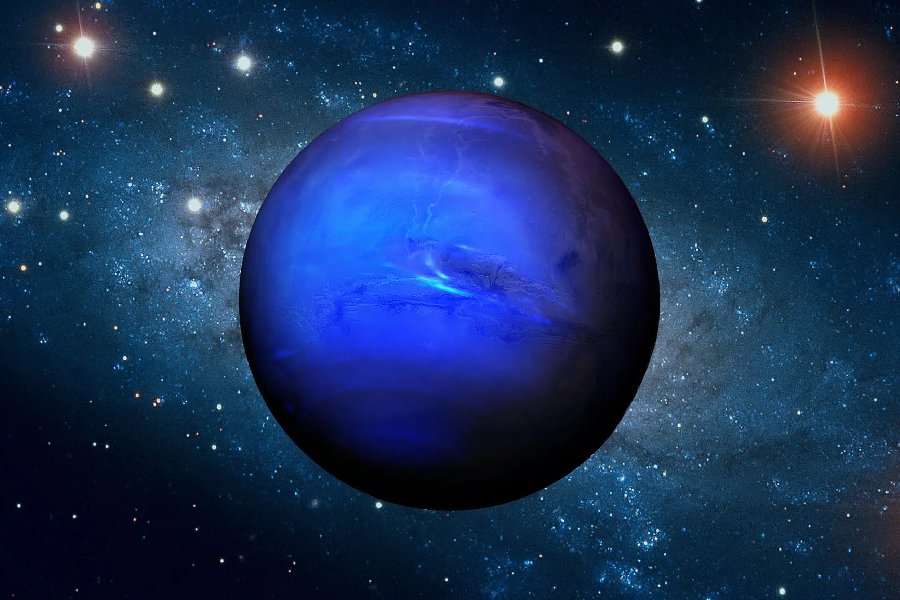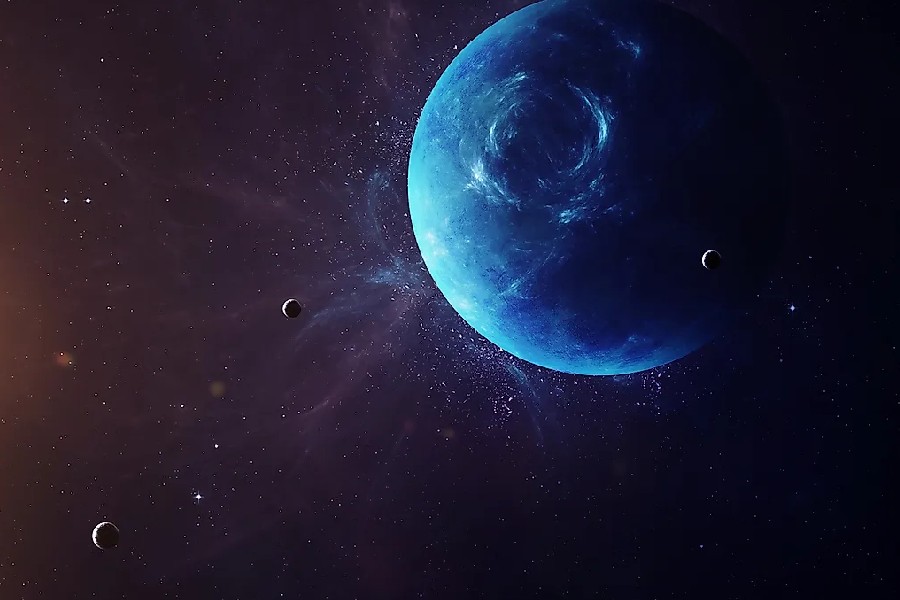Neptune is an ice giant that floats outside Uranus’ orbit and is always covered in twilight. This remote ice giant presides over its obscure domain some 30 times further than Earth’s distance from the Sun. In the murky darkness, one might expect little could take shape or thrive. But how many moons does Neptune have, and what are their names?
It hosts an array of natural satellites that carve icy trails around this celestial loner. From the dynamic Triton with erupting plumes to tiny Naiad only 60 miles wide, Neptune’s current family of confirmed moons offers intrigue and invites discovering even more unnamed worlds.
Unveiling the origins and properties of each provides insight into Neptune’s past in the formative eons of the solar system. Let’s review the facts about Neptune’s moons and what awaits more exploration.

How Many Moons Does Neptune Have?
Neptune has 14 known moons. But what are the names of Neptune’s moons? The largest moon of Neptune is Triton, a unique moon that orbits the planet in a retrograde direction, opposite to Neptune’s rotation. These moons vary in size, composition, and orbital characteristics.
The other known moons of Neptune are much smaller and are classified into two groups: regular moons and irregular moons. Regular moons have more circular and predictable orbits, while irregular moons have more eccentric and unpredictable paths.
Discovery of Neptune’s Moons
Neptune was first observed using a telescope in 1846, but scientists could not determine if any satellites circled the lonely blue planet because of its great distance.
It was not until the late 1800s that observations confirmed the first definitive moons, but many more discoveries followed decades later from flyby probes. Each Neptunian moon uncovered offered new details about this mysterious region.
The Discovery of Triton
British astronomer William Lassell detected Neptune’s unusually large moon, Triton, mere weeks after the planet’s initial discovery. However, it would take modern analysis to unveil Triton’s bizarre retrograde orbit.
Frozen Triton, over 1,680 miles wide, stands as the seventh-largest moon in the solar system. It is a dynamically active world with geological features that were only later revealed.
Nereid
In 1949, American astronomer Gerard Kuiper discovered a tiny, distant Nereid. Cold Nereid orbits far further from Neptune than any other moon in the modern era, with an average distance of more than 3 million miles.
Nereid has a highly eccentric orbit that takes 360 days to complete one full elliptical loop. This irregular path carries frigid Nereid far beyond Neptune’s rings and other satellites. Kuiper’s identification showcased the complexity of satellites that threaded this distant realm.
Larissa
Astronomers had to wait until 1981 and advances in telescopic equipment before new Neptunian moons emerged.
In that year, Johann Galle, a German observer, identified Larissa. Its nearly circular orbit, only about 124 miles wide, within the planet’s ring plane, proved intriguing given its location deep in Neptune’s gravity.
Proteus and Despina by Voyager 2
When NASA’s Voyager 2 probe completed a landmark flyby of Neptune’s satellites in 1989, it finally illuminated them in full. Capturing images and scans of multiple new moons, Voyager 2 revealed cratered, dark Proteus measuring about 260 miles wide in a synchronized orbit with Neptune’s magnetic field.
Tiny Despina, measuring only 93 miles across, orbited within Neptune’s rings. Its embedded path may have influenced the dynamics of the rings. These discoveries set the framework for Neptune’s modern satellite tally.

Further Discoveries of Smaller Moons by Hubble Space Telescope
NASA’s Hubble Space Telescope has revolutionized astronomy throughout the universe since its launch in 1990. High above distortion from Earth’s atmosphere, Hubble’s crisp optics uncovered galaxies billions of lightyears away and fundamentally shifted cosmic understanding. Closer to home, Hubble also revealed intricate new details about our outer solar system planets, and moons.
So, focusing its precise gaze on Neptune, Hubble proved crucial for expanding our knowledge of satellites too small or dim for earlier detection.
Hubble’s contribution
After Voyager 2’s 1989 flyby captured images of six previously unknown Neptunian moons down to just 10 miles in diameter, Hubble took the next leap in moon detection starting in 2002.
Peering deep into orbits beyond Neptune’s brightest satellites, Hubble data first revealed a tiny S/2002 N1 just 15 miles wide. The following year, Hubble spotted a second mini-moon, S/2003 N1, scarcely larger at 18 miles across.
Moreover, two more pico-sized moons joined the roster in archival searches of Hubble images from 2004 and 2013. These faintest sparks orbiting Neptune hinted at the abundance and variety of mini-moons likely still hiding beyond the glare of large neighbors like Triton or Proteus.
Scientific impact
Uncovering these faint companion objects extended our understanding of how populated the realm around ice giants could be. Models suggest hundreds more pico moons may circle the interior undetected to the brighter major satellites caught by Voyager 2.
Each new Hubble sighting raises questions about the prevalence of micromoons and the capture efficiency history of the outer planets. Astronomers use Hubble to refine search areas based on discoveries. They expect further findings, gradually exposing Neptune’s total satellites.
Orbits and Movements Around Neptune
The paths and motions of moons around planets provide insights into the gravitational forces at play. Neptune demonstrates a range of orbital dynamics among its 14 known satellites. Tracking these movements reveals Neptune’s gravitational grip in action.
Orbital dynamics
Inner moons like Naiad race around Neptune in tight, rapid orbits, completing circuits in just seven hours. Mid-range moons such as Despina, Galatea, and Larissa circle Neptune in synchrony, exhibiting stable, resonant orbits. Most display generally circular paths along the planet’s equator.
But distant, irregular moons like Nereid follow highly elongated orbits spanning millions of miles over the years, subjected to external distortions. These erratic movements contrast the orderly control Neptune exerts on its inner realm.
Effects of Neptune’s gravity
Neptune’s gravity propels inner moons to dizzying speeds while keeping more eccentric distant moons like Nereid on a lengthy leash. Consequently, resonant orbital zones create stable paths for satellites. These paths result from Neptune’s rhythmic gravitational interactions across vast distances.
Conclusion
How many moons does Neptune have? We explored the 14 worlds that spark and have been proven, as well as the number of smaller moons that might yet sneak past Neptune’s domain.
Understanding the diversity across our solar system’s outer edge, from geyser-erupting Triton to tiny Naiad, helps us grasp the dynamics of sculpting orbits. This knowledge enhances our understanding of the frontier territories.
As our ability to detect objects in space improves in the coming decades, we might see more Neptunian moons emerging from the darkness. This discovery would help us learn more about the orbital areas around ice giants.
Until then, we may imagine undiscovered satellites quietly moving through Earth’s skies. This keeps our curiosity alive about how populated our farthest planetary neighbor’s surroundings might be.
